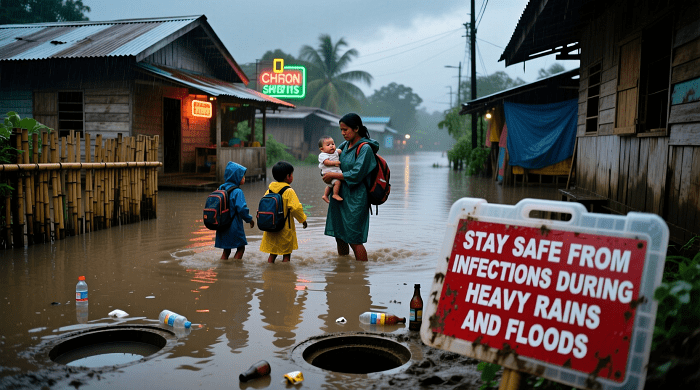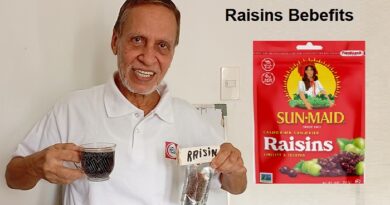Safe from 5 common Infections During Rainy Season in the Philippines
The rainy season in the Philippines typically spans from June to November. It brings much-needed respite from the summer heat. Still, it also poses significant health risks due to heavy rains and flooding. The increase in waterborne diseases and other infections during this period is a major concern. It requires heightened awareness. Proactive measures are needed to protect public health.
Understanding the Risks
The heavy rains and floods characteristic of the rainy season create an environment conducive to the spread of various infections. Contaminated water sources, poor sanitation, and increased exposure to disease-carrying vectors all contribute to the heightened risk.
Waterborne Diseases
One of the primary dangers during the rainy season is the surge in waterborne diseases. These illnesses are caused by pathogens present in contaminated water and can lead to a range of health problems.
- Leptospirosis:
This bacterial infection spreads through contact with contaminated water or soil. The contamination is caused by the urine of infected animals, particularly rats. Flooding increases the risk of exposure. Symptoms can range from mild flu-like illness to severe kidney damage. In severe cases, it can lead to liver failure and even death. - Typhoid Fever:
This bacterial disease spreads through contaminated food and water. Poor sanitation and hygiene practices during floods can lead to outbreaks, with symptoms including fever, abdominal pain, and diarrhea. - Cholera:
Another bacterial infection, cholera, is caused by ingesting contaminated water or food. It can cause severe diarrhea and dehydration, leading to rapid health deterioration if left untreated. - Hepatitis A:
This viral liver infection is transmitted through the fecal-oral route, often via contaminated water or food. Symptoms include fever, jaundice, and abdominal discomfort. - Read more about: Common Bacterial Infections in the Philippines: Your Health Guide
Vector-Borne Diseases
The rainy season also promotes the breeding of mosquitoes, leading to an increase in vector-borne diseases.
- Dengue Fever:
Dengue fever is a viral illness. It is transmitted by Aedes mosquitoes. The illness can cause high fever, severe headache, joint and muscle pain, and a rash. In severe cases, it can lead to dengue hemorrhagic fever, which can be fatal. - Malaria:
While less prevalent in urban areas, malaria remains a risk in certain regions of the Philippines. It is transmitted by Anopheles mosquitoes and causes fever, chills, and flu-like symptoms. Severe malaria can lead to organ failure and death.
Other Infections
Moreover to waterborne and vector-borne diseases, the rainy season can also increase the risk of other infections.
- Skin Infections:
Prolonged exposure to floodwaters can lead to skin infections as athlete’s foot, fungal infections, and wound infections. Contaminated water can harbor bacteria and fungi that cause skin irritation, itching, and inflammation. - Upper Respiratory Diseases:
Overcrowded evacuation centers and damp living conditions can spread of respiratory infections. These include the common cold, flu, and pneumonia. These infections can be particularly dangerous for young children and individuals with underlying health conditions.
Prevention
The risk of infections increases during the rainy season. It is a signal to take proactive measures to protect yourself and your family.
Water Safety
- Drink Safe Water:
Make sure you drink safe water. Boil the water for at least one minute. Alternatively, use a reliable water filter. Avoid drinking water from questionable sources. - Practice Good Hygiene:
Wash your hands with soap and water, especially before meals and after using the toilet. This simple practice can significantly reduce the risk of waterborne diseases. - Avoid Floodwaters:
If possible, avoid wading through floodwaters. If exposure is unavoidable, wear protective gear as boots and gloves. Wash thoroughly with soap and water after contact.
Mosquito Control
- Remove Breeding Sites:
Regularly empty containers that can collect water, as flowerpots, tires, and buckets. These stagnant water sources are breeding grounds for mosquitoes. - Use Mosquito Repellent:
Apply mosquito repellent containing on exposed skin. Follow the instructions on the product label and reapply as needed. - Wear Protective Clothing:
Wear long sleeves and pants, especially during dawn and dusk when mosquitoes are most active. Consider using mosquito nets while sleeping, particularly if your home is not well-screened.
Food Safety
- Cook Food Thoroughly to kill any harmful bacteria or viruses. Pay particular attention to meat, poultry, and seafood.
- Store Food Properly at proper temperatures to prevent bacterial growth. Refrigerate perishable items promptly and avoid leaving food at room temperature for extended periods.
- Wash Fruits and Vegetables thoroughly before consumption, especially if they will be eaten raw. Use clean water and a vegetable brush to remove dirt and contaminants.
General Health Measures
- Strengthen Your Immune System. A strong immune system can help you fight off infections.
- Stay Informed: Keep up to date with weather forecasts and health advisories from local authorities. This will allow you to take prompt precautions and avoid unnecessary risks.
- Seek Medical Attention: If you experience symptoms of an infection, like fever, diarrhea, or skin rash, seek medical attention promptly. Early diagnosis and treatment can prevent complications and improve outcomes.
Government and Community Initiatives
Addressing the health risks linked to the rainy season requires a collaborative effort involving government agencies, local communities, and individuals.
Public Health Programs
- Disease Surveillance: Strengthening disease surveillance systems to detect and respond to outbreaks promptly. This includes monitoring disease trends, conducting laboratory testing, and implementing control measures.
- Health Education: Conducting public health campaigns to raise awareness about the risks of infection and promote preventive measures. These campaigns can utilize various channels, as television, radio, social media, and community outreach programs.
- Vaccination Programs: Implementing vaccination programs to protect against vaccine-preventable diseases as typhoid fever and hepatitis A. Vaccination can give long-term immunity and reduce the burden of these infections.
Infrastructure Improvements
- Drainage Systems: Investing in improved drainage systems to reduce flooding and prevent the accumulation of stagnant water. Proper drainage can reduce the breeding of mosquitoes and the spread of waterborne diseases.
- Water and Sanitation Facilities: Improving water and sanitation facilities to ensure access to safe drinking water and proper waste disposal. This includes constructing and maintaining water treatment plants, sewage systems, and public toilets.
Conclusion
The rainy season in the Philippines presents significant health challenges due to the increased risk of infections. We can protect ourselves by understanding the risks and taking preventive measures. Working together as a community is important.
Stay informed, stay prepared, and stay safe this rainy season.
For More Reading:
- Department of Health Philippines: https://doh.gov.ph/
- World Health Organization Philippines: https://www.who.int/philippines
- Philippine Atmospheric, Geophysical and Astronomical Services Administration (PAGASA): http://bagong.pagasa.dost.gov.ph/
Call to Action:
Worried about the risks of infection this rainy season? Visit us at Helal Medical for vaccinations. Stock up on essential hygiene supplies. Don’t wait, act now!




